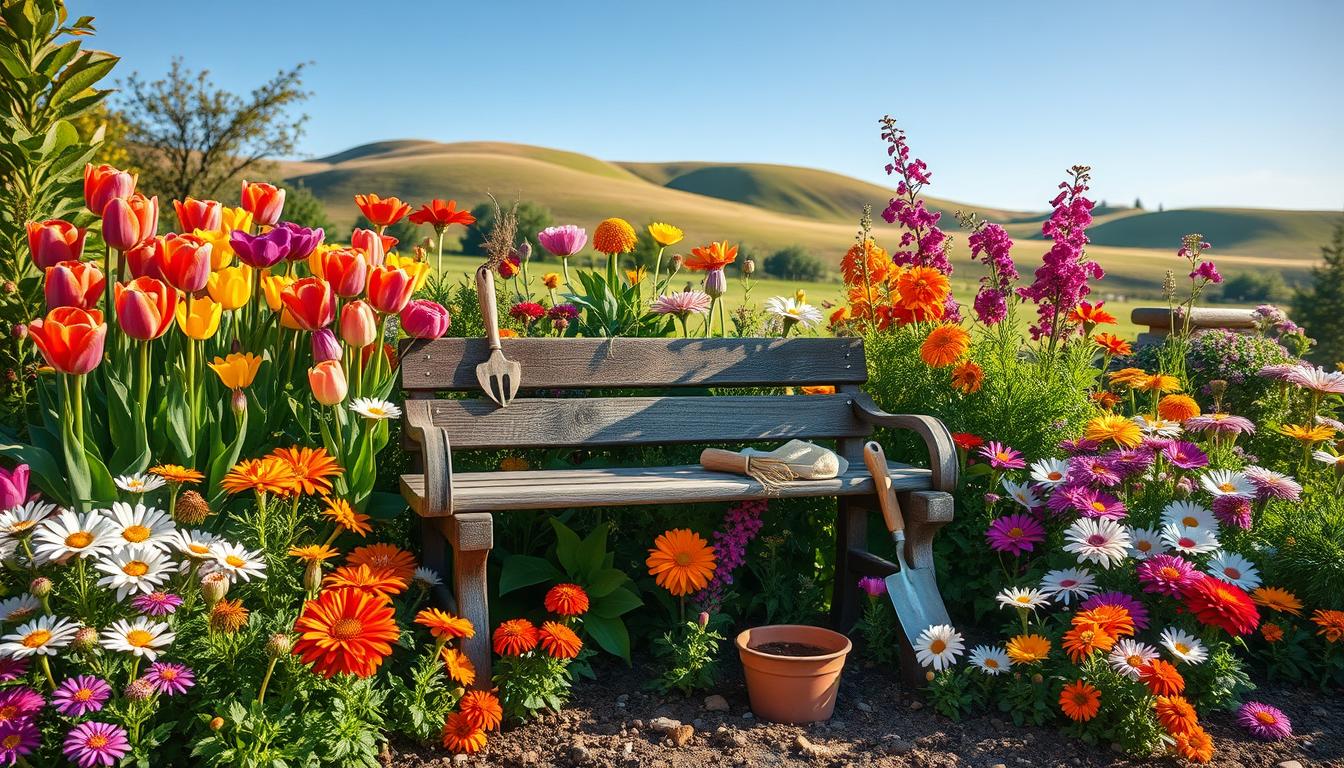I’m excited to share with you the importance of creating a seasonal flower planting guide. It enhances your garden’s beauty. By knowing the best time to plant flowers, your garden will thrive all year.
A well-planned guide considers climate, soil, and flower types for each season. This is key for a successful garden.
With a seasonal flower planting guide, your garden will bloom at the perfect time. Enjoy a colorful garden all year by following the best planting times.
By planning carefully, you’ll grow a stunning garden. It will bring joy and beauty to your outdoor space. That’s what a seasonal flower planting guide is all about.
Understanding Seasonal Flower Planting
To have a thriving garden, knowing when to plant flowers is key. This means planting at the right time for each flower to bloom in its season. An annual flower planting calendar helps plan for a garden full of colors all year.
Seasonal planting is important because flowers bloom at different times. Some bloom in spring, others in summer or fall. Knowing these times lets you create a garden that changes with the seasons. Perennial flower planting tips help too, as they come back year after year.
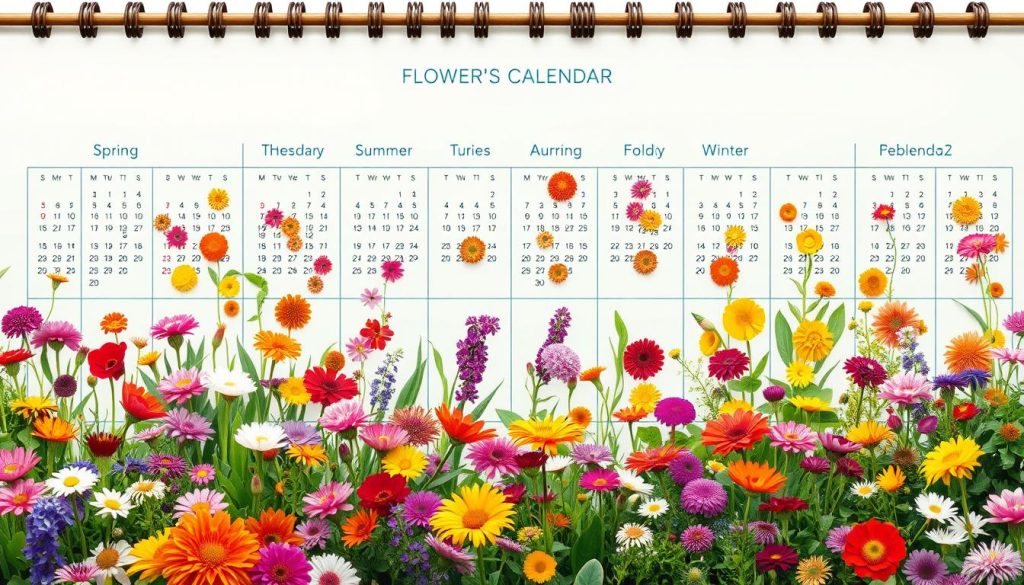
- Research the bloom times of different flowers to determine when to plant them
- Choose flowers that thrive in your local climate and soil type
- Plan for a mix of annuals and perennials to ensure a constant display of color
By following these tips and making an annual flower planting calendar, you can have a beautiful garden all year. Don’t forget to use perennial flower planting tips to get the most from your garden.
| Season | Flowers to Plant | Bloom Time |
|---|---|---|
| Spring | Tulips, Daffodils, Hyacinths | March to May |
| Summer | Sunflowers, Zinnias, Marigolds | June to August |
| Fall | Asters, Chrysanthemums, Sedum | September to November |
Spring Flowering Plants
Starting with flowers can seem tough, but a beginner’s guide can help. It shows how to pick the best flowers for spring. You’ll learn about colors, textures, and when they bloom.
Spring has many flower types, like bulbs, perennials, and annuals. Tulips, daffodils, and hyacinths are great for color. A beginner’s guide teaches you to pick flowers that bloom when they should, making your garden lively.
Best Varieties for Spring Blooms
- Tulips: These cup-shaped flowers come in a variety of colors and are perfect for adding a splash of color to your garden.
- Daffodils: With their bright yellow petals and trumpet-shaped centers, daffodils are a classic spring flower.
- Hyacinths: These fragrant flowers are perfect for adding a sweet scent to your garden and come in a range of colors.
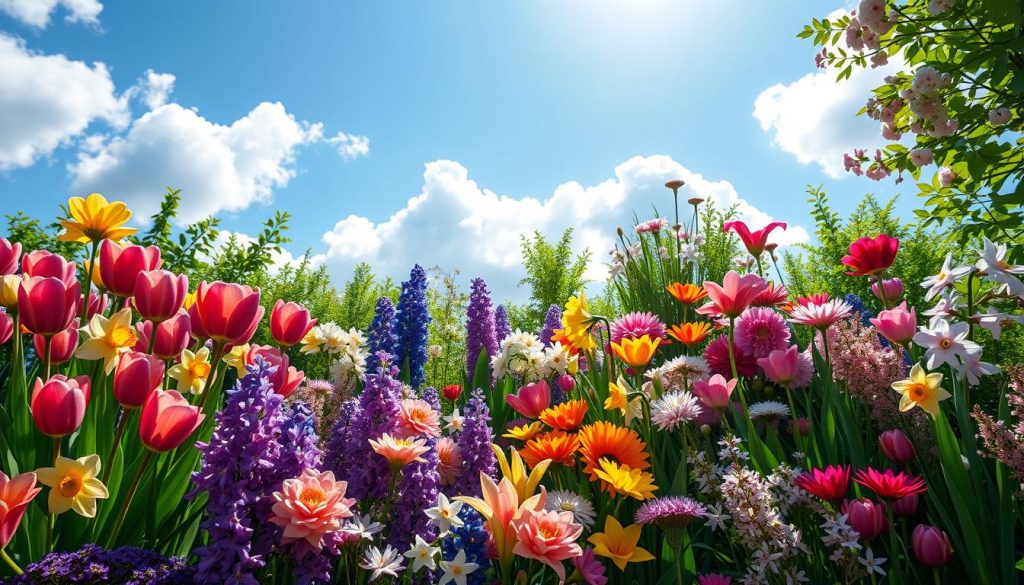
Planting Tips for Spring Flowers
To make your spring flowers bloom well, follow some key tips. Prepare the soil, plant at the right time, and give them the care they need. With these tips and a beginner’s guide, your garden will be stunning.
With the right knowledge, you can pick flowers that make your garden beautiful. It becomes a peaceful place for relaxation and fun.
Summer Flowering Plants
With the warm weather here, it’s time to pick the best flowers for summer. A good flower garden planting schedule is key to keep your garden colorful all summer. I choose a mix of annuals, perennials, and tropicals that love the heat.
Top Choices for Summertime Color
My top picks for summer flowers are sunflowers, zinnias, and hibiscus. They’re not only stunning but also easy to care for. When planning your garden, remember each plant’s needs, like water, food, and pruning.
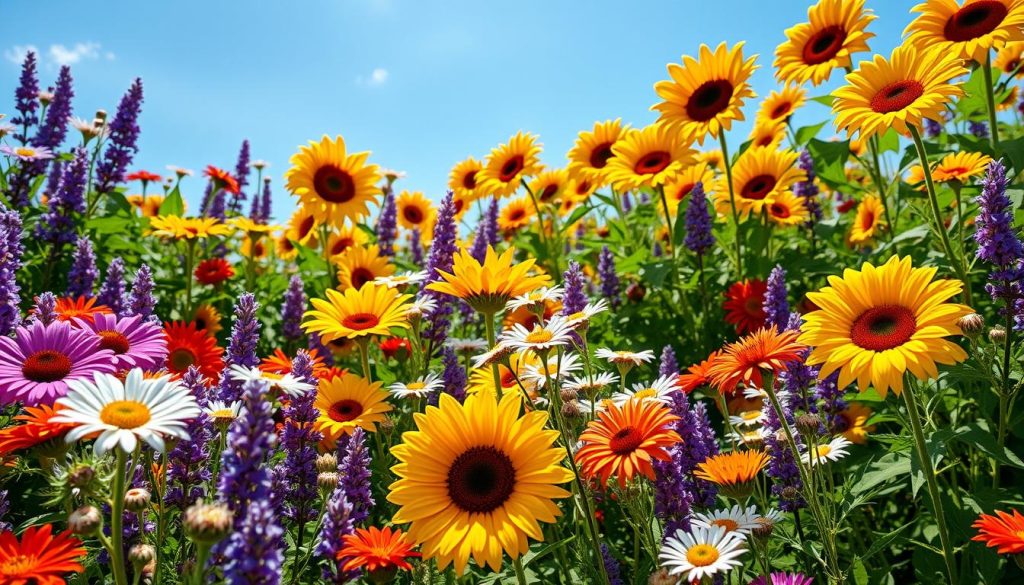
Maintenance Tips During Hot Months
To keep your summer flowers looking great, they need the right care. Here are some tips:
- Water them deeply but not too often to help roots grow deep
- Feed them regularly with a balanced fertilizer
- Remove dead flowers to make them bloom more
By following these tips and planning your garden, you’ll have a beautiful summer garden all season.
Fall Flowering Plants
As summer ends, it’s time to think about planting flowers for a beautiful autumn. A good seasonal flower planting guide is key for a stunning fall garden. There are many types of fall flowers, like perennials, annuals, and bulbs.
It’s important to know what each plant needs for autumn blooms. Some plants need pruning or dividing in the fall. A seasonal flower planting guide helps ensure your fall flowers get the care they need.
Planting and Care Tips for Fall Flowers
Here are some important tips for planting and caring for fall flowers:
- Choose plants that fit your climate and soil
- Plant at the right time for your area
- Prepare the soil well, including fertilizing and pest control
By following these tips and a good seasonal flower planting guide, you can have a beautiful fall garden. It will attract visitors and show off stunning colors and textures.
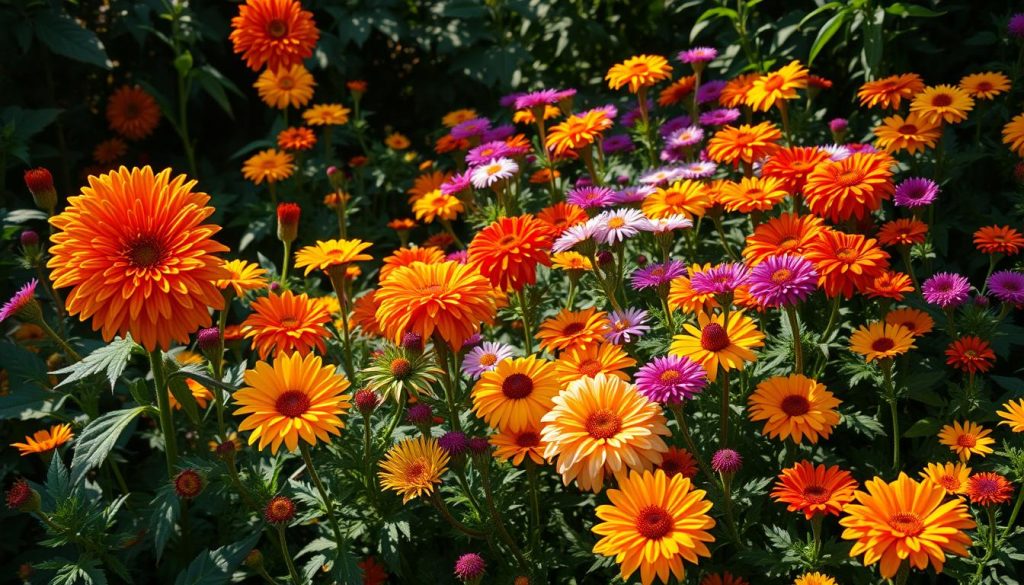
Popular fall flowers include asters, chrysanthemums, and sedum. These plants are easy to care for and grow well in many conditions. Adding these to your seasonal flower planting guide will make your fall garden stand out.
| Plant | Planting Time | Soil Requirements |
|---|---|---|
| Asters | August-September | Well-draining soil |
| Chrysanthemums | September-October | Fertile soil with full sun |
| Sedum | October-November | Dry to medium soil |
Winter Flowering Plants
Many gardeners think their gardens will be empty in winter. But, with the right planning, you can have a vibrant garden even in cold months. It’s key to have a calendar for planting winter flowers to keep your garden colorful.
Start by adding unique winter plants like bulbs, perennials, and shrubs. Snowdrops, winter aconite, and hellebores are great choices. They’re not just pretty; they also feed pollinators in winter.
Protecting Flowers from Frost
To keep your winter plants safe from frost, use mulching, covering, and indoor protection. Mulching keeps the soil warm and moist. Covering with burlap or fleece shields plants from wind and frost. Moving plants indoors can also make them bloom longer.
- Mulch around plants to insulate the soil and retain moisture
- Cover plants with a layer of burlap or fleece to protect from harsh winds and frost
- Bring plants indoors or to a protected area to extend their blooming period
By using these tips and adding winter plants to your calendar, your garden will stay beautiful all year.
Creating a Flowering Calendar
Creating a flowering calendar is key for a colorful garden all year. It helps you know when to plant, prune, and fertilize. This way, your garden stays vibrant and beautiful.
Let’s look at a monthly planting checklist. It shows how to pick flowers that do well in your area. Here’s a simple guide:
- January: Plant winter bulbs like tulips and daffodils
- February: Prune roses and feed your flowers
- March: Plant bulbs for spring, like crocuses and hyacinths
- April: Start seeds for summer flowers, like marigolds and zinnias
- May: Plant warm-season flowers, such as sunflowers and cosmos
- June: Remove dead flowers and feed your plants
- July: Plant flowers that handle heat, like lantana and verbena
- August: Start seeds for fall flowers, like asters and chrysanthemums
- September: Plant cool-season flowers, like pansies and violas
- October: Feed your flowers and get ready for winter
- November: Plant bulbs for winter, like cyclamen and snowdrops
- December: Prune your flowers and enjoy the holidays
By following this checklist, you’ll have a beautiful garden. Remember to pick flowers that fit your climate. With this guide, you’ll have a garden that blooms all year.
| Month | Planting Tasks | Seasonal Care |
|---|---|---|
| January | Plant winter-flowering bulbs | Protect plants from frost |
| February | Prune rose bushes | Fertilize existing flowers |
| March | Plant spring-flowering bulbs | Start seedlings for summer flowers |
Soil Preparation Techniques
To make your flower garden bloom, focus on soil preparation. Good soil is key to a healthy garden. It affects how well your flowers grow.
When picking flowers for each season, think about their soil needs. A good soil plan helps you know when to plant. It also makes sure your flowers get the nutrients they need.
Here are important things to think about when preparing your soil:
- Soil pH: Flowers need different pH levels. Test your soil to find out its acidity.
- Soil composition: The right mix of clay, silt, and sand helps flowers grow strong.
- Nutrient levels: Your soil should have nitrogen, phosphorus, and potassium for flower growth.
Understanding these points helps you create a great flower garden. Choose flowers that do well in your area and soil.
Here’s a simple table to help you start with soil preparation:
| Soil Type | pH Level | Nutrient Requirements |
|---|---|---|
| Clay | 6.0-7.0 | High phosphorus, moderate potassium |
| Silt | 6.5-7.5 | Moderate nitrogen, high potassium |
| Sand | 7.0-8.0 | High nitrogen, low phosphorus |
Fertilizing for Optimal Growth
To make your flower garden thrive, knowing about fertilization is key. Your seasonal flower planting guide should cover the best times to plant and how to fertilize. A good fertilization plan can greatly improve your garden’s health and beauty.
There are many fertilizers to choose from, like organic and inorganic ones. Compost, manure, and synthetic fertilizers are popular. It’s important to pick the right fertilizer for your flowers and soil. For spring planting, a fertilizer rich in phosphorus is good for root growth.
Types of Fertilizers to Use
- Compost: A natural, organic fertilizer made from decomposed plant matter
- Manure: A nutrient-rich fertilizer made from animal waste
- Synthetic fertilizers: Inorganic fertilizers made from chemical compounds
Knowing when and how to fertilize is crucial. Fertilize your flowers during the growing season, from spring to fall. Also, check your soil’s pH level and adjust your fertilizing plan. With a good seasonal flower planting guide and proper fertilizing, your garden will bloom all year.
Pest Control Strategies
To keep your flower garden healthy and blooming, it’s key to use good pest control. When planning your annual flower planting calendar, think about using perennial flower planting tips to avoid pests. Knowing the common pests that harm flowers helps you prevent them and protect your garden.
Watch out for aphids, whiteflies, and spider mites. These pests can really damage your flowers. It’s important to spot them early and act fast. Use physical barriers like fine-mesh screens to keep them away. Also, introducing beneficial insects that eat pests can help.
Organic pesticides are another option. Neem oil and insecticidal soap are good choices. Always read the instructions and protect beneficial insects. By using these methods, your flower garden will stay healthy and beautiful all year.
| Pest | Control Method |
|---|---|
| Aphids | Neem oil, insecticidal soap |
| Whiteflies | Yellow sticky traps, fine-mesh screens |
| Spider mites | Insecticidal soap, horticultural oil |
Creating a Pest Management Plan
By following these tips and adding pest control to your garden plan, you can make a solid pest management plan. Always use perennial flower planting tips and act early to stop pests.
Designing Your Flower Bed
Designing your flower bed is fun and creative. Think about the bloom time, color, and texture of each flower. This helps you create a beautiful display.
Start by choosing flowers that bloom at different times. For spring, pick tulips, daffodils, and hyacinths. This makes your garden change and look great all season.
Tips for Arranging Your Flowers
- Choose a mix of annuals and perennials for a dynamic display
- Think about the height and spread of each plant for balance
- Use different colors and textures to add depth and interest
Color and texture are key in flower bed design. Add garden ornaments, pathways, and more to make your garden stunning. A winding path or a sundial can make your garden special.
Incorporating Color and Texture
| Season | Flower Varieties | Color and Texture |
|---|---|---|
| Spring | Tulips, Daffodils, Hyacinths | Pastel colors, delicate petals |
| Summer | Sunflowers, Zinnias, Marigolds | Bright colors, bold textures |
| Fall | Asters, Chrysanthemums, Sedum | Warm colors, soft textures |
Follow these tips to make a beautiful flower garden. With the right flowers and design, your outdoor space will be filled with joy and beauty.
Harvesting and Enjoying Your Blooms
As the seasons change, your flower garden blooms beautifully. It’s time to enjoy the fruits of your labor. Learn when to cut flowers for vases and how to make beautiful arrangements. This way, you can bring the garden’s vibrant colors and fragrances indoors.
When to Cut Flowers for Vases
The best time to cut flowers is in the morning. This is when they are fresh and full of water. Avoid cutting during the hottest part of the day, as they might wilt faster. Use sharp, clean tools and leave some stem length for your arrangements.
Creating Beautiful Arrangements
With your fresh flowers, you can make stunning bouquets and centerpieces. Try different colors, textures, and heights for a beautiful display. Remember to condition the flowers by trimming stems and changing water to keep them fresh longer.
By planning your flower garden planting schedule, you’ll always have a fresh supply. This way, you can enjoy your blooms both in the garden and at home.

